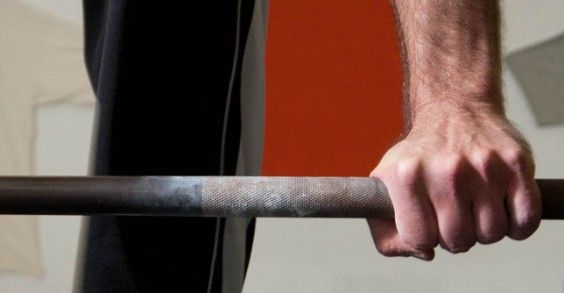In the gym, there are the people who mindlessly go through sets and reps of arbitrary movements — not paying attention to cumulative volume, a set program, or whether or not a given exercise is even good for their bodies.
Then there’s you.
You train hard, and you do your best to train smart. You utilize resources just like this one to amass your training knowledge from the pros — and you apply what you’ve learned. The good news? You’ve got the body to show for it. Progress is not scanty, and you can hold your own in the weight room in an unannounced-no-particular-reason lifting contest, should there ever be one.
The Problem

Amongst all this solid training, you’ve seen gains and kept injury free. But now, you’ve hit a plateau. You can’t seem to get past a pesky stymie that’s cutting your linear flow of progression. What’s worse is that you’ve tried alternate lifting methods like tempo reps, 1.5 reps, and cluster sets. The issue is, you’ve heard these methods are most applicable to the super-advanced and possibly competitive. For those reasons, they’ve given you minimal improvements.
With this in mind, it may be a good idea to take on the mindset of being more simplified rather than more complex. A peek into deadstop training may be just the ticket.
What’s Deadstop Training?
This term really refers to making sure that every rep of a given exercise is performed with zero momentum. This will inhibit the stretch reflex to take over in various movements, to kill the “rebound” effect that happens to get through the hardest part of each lift. Having to move from a “dead stop” with zero momentum can be a game changer in terms of muscular activation. It can also be a very humbling experience in the weight room, because it can provide a window into just how much work your muscles are being put through when training, rather than relying on elastic forces and momentum.
According to a study performed by the Department of Kinesiology at Midwestern State University, almost half of the subjects who underwent a form of heavily loaded deadstop training (squatting) showed an increase in force production for their vertical jump 30 seconds after their work set
More Benefits
In many cases, deadstop training can result in safer variations of the alternative conventional methods of lifting. The reason for this is because in many exercises, the full stop allows you to re-establish proper lifting position, which does two things:
- Re-establishes proper muscles to be set for recruitment (more isolation!)
- Prevents injury (due to less “breakdown” technically)
For beginning lifters, this would be a great way to establish the cues necessary to develop proper motor patterns. At the same time, this technique, would tend to be too difficult to achieve many quality sets. With this in mind, deadstop training fits very nicely into the program of an intermediate trainee who has considerable time in the gym under his or her belt. Let’s focus on the big movements.
Deadlifts
There are typically two ways to do deadlifts: The tap-and-go method, where the bar simply glances off the ground between reps, and the deadstop method, where the bar settles on the ground for at least a full second. This variation of deadstop training is arguably the most common and widely seen. Again, performing deadlifts in this fashion will encourage the lifter to “reset” his back muscles between reps and get tight again, as a preventive tool against injury. Since it’s such a big movement, don’t be afraid to let the weight dictate how long you take to reset between reps. I’ll use myself as an example. In this video, you’ll see me pulling 225 with the deadstop method. Since the weight is manageable, I don’t rest too long, but ensure the bar settles.
But in this video, I’m lifting almost twice the weight as the first video; therefore I take longer to reset.
Especially for sets of under 10 reps, deadstop deadlifts can turn into a very effective exercise, and also a test of “true strength.” Injury prevention aside, it’s a great way to light up your muscles to do as much as they should for each rep.
Squats
There’s no particular “deadstop squat” exercise, but there are ways to employ the same methodology. Box squats are my personal favorite. Box squatting is tricky — the idea is to ensure that you keep a neutral spine through the entire range of motion, meaning the height of the box matters. Start things off by squatting to a box that brings you down to about 90 degrees from the floor. Pause on the box, and make sure to stay tight! Do not relax while your weight is on the box. Keep your muscles tense and flexed. Count to 1, and drive up through the heels off the box. You can use a front squat load or a back squat load for this exercise. As your range of motion improves, you can start using a lower box.
Bottom-up squats are a good alternative for those who have spine issues or major depth issues. Instead of setting up a box, set the safety pins in your squat cage high enough for the bar to settle on them at a point during your squat. Stay tight, and lower the bar to the pins. Pause for a full second, and drive up off the pins. This variation allows the spine to be load-free at the bottom of the lift, and can save the day for people with a history of problems, especially when lifting heavy.
As Josh Bryant of elitefts.com says, “dead squats develop rate of force development (RFD), which is how quickly one can develop tension in a muscle. Concentric-only muscle actions, with no negative loading phase, offer huge gains in RFD. There isn’t a stretch shortening cycle to help you, so you must develop tension in the muscle quickly if you’re going to get it moving.”
Pressing
Powerlifters in competition have to allow the bar come to a complete stop on the torso when performing a bench press, before pushing to complete the rep. Especially in this exercise, it can be beneficial not only for developing strength, but also for developing motor control. The bench press is a slightly trickier exercise where elbow position and bar path are a trifle more difficult to perfect while the bar is in motion. This will help the body to engrain such patterns. Use the pause at the bottom for all your other pressing too, whether it’s dumbbell shoulder press, barbell standing press, or even applying it to a Z-Press!
You can also apply the same methods as the bottom-up squats into your bench press. Set up a bench in the squat cage, and perform pin presses. Set the pins about 4 to 6 inches higher than the chest, and let the bar settle down to the pins. Take the opportunity to reset the back and stay tight between each rep. For this exercise, keep the reps low, and don’t be afraid to lift heavier weights.
One More Move and Wrapping It Up
If you’re really looking to humble yourself, one more deadstop exercise to focus on would be a pull-up. Most everybody relies on their stretch reflex without even thinking at the bottom of their pull-up. This is a way to really develop starting strength for the lift. You can kick your weight belt to the curb and substitute a few sets of these bad boys. I’ll bet your bottom dollar you won’t perform ¾ the total number you’re used to.
Whether you decide to sprinkle these methods into your training program, or decide to make an entire program chock full of this stuff, they’re going to have a positive impact on your strength, and help you send your plateaus to the crypt. Don’t let your training pride get in the way of seeing actual results. The point of exercise is to break your muscles down to an extent in the weight room, so be smart and address your weaknesses. Deadstop training could be just what the doctor ordered for dormant results.
Have you ever tried deadstop training? Let us know in the comments below our tweet the author @coachleeboyce.

